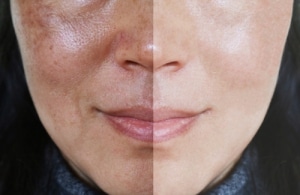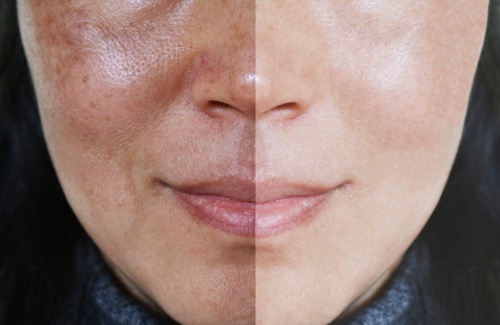
What Causes Hyperpigmentation?
The worst culprit of pigmentation disorders is cumulative sun exposure. UV exposure triggers the production of melanin – the pigment responsible for protecting skin from injury. Melanin works hard to keep UV rays from deposing energy onto and into the skin. Repeated, unprotected exposure disrupts the production of melanin and leads to a build-up of darker cells in the exposed skin areas.Hormonal changes during pregnancy often lead to melasma, which is another form of hyperpigmentation also known as the “the mask of pregnancy.” About 70% of pregnant women develop brown patches or spots on their face, upper lips, cheeks and forehead, as well as their bellies. In most cases, melasma clears up on its own after birth; however some patients, especially those with darker skin tones, may experience long-term discoloration.
Dark marks from acne can often develop in areas where blemishes have been. The same is true for insect stings, cuts, bruises, kitchen burns, and other skin traumas. These marks often take months to fade and some never fade much at all. Post-inflammatory hyperpigmentation is also more common in darker skin types.
Containing Hyperpigmentation Through Treatment
ZO Skin Health 3-Step Peel™
https://youtu.be/CCodrsdXRN0Designed to address melasma, post-inflammatory pigmentation and sun-induced discoloration, this potent stimulating peel provides longer lasting benefits beyond the temporary superficial improvements seen with ordinary peels. Post-procedure peeling is mild, with minimal downtime.
ZO Skin Health Controlled Depth Peel™
https://youtu.be/41pRXywWEwQDesigned to target the most persistent forms of hyperpigmenattion, this peel offers controlled absorption and penetration of treatment and excellent anti-inflammatory properties. Peeling, irritation and darkening of pigmentation is expected for a few days after treatment.
Intense Pulsed Light
IPL therapy uses a beam of light to bring spots to the skin’s surface and gently sloughs them off. It’s a great option for persistent discoloration, however patients should be prepared to experience some redness, minor swelling and a darkening of the pigmentation a few days after the treatment.
Fractional Laser Treatment
This is the bridge between an ablative and non-ablative procedure in which a laser beam is used to minimize the appearance of pigmentation. Mild redness and swelling can be expected for a few days after treatment.
Micro-needling
It’s a device with tiny needles that prick the skin to improve the appearance from acne scars and pigmentation. Most patients experience mild redness for up to 48 hours post-treatment.
 By Yoana
By Yoana